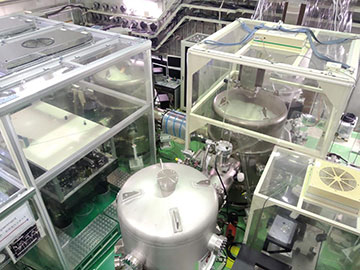![]()
Researchers using a cavity from the TAMA300 detector at the National Astronomical Observatory of Japan (shown here) have demonstrated how to reduce noise in low-frequency gravitational waves. [Image: Kestrel/Wikimedia Commons, CC-BY-SA-3.0]
Gravitational-wave detectors provide a unique view of some of the most extreme phenomena in the universe, but currently work best at relatively high frequencies. That’s because scientists have devised a way of limiting the quantum noise that would otherwise blur such measurements.
But now two groups of researchers have shown how a suitable optical cavity could be used to minimize noise at lower frequencies as well (Phys. Rev. Lett., doi: 10.1103/PhysRevLett.124.171101, 10.1103/PhysRevLett.124.171102). They say that inserting such cavities in the world’s leading observatories should significantly boost measurements of coalescing black holes and other violent astrophysical events.
A high-frequency fix
Gravitational waves are ripples in space-time generated by the acceleration of extremely massive and compact (celestial) objects. Their passage through the Earth can be detected via laser beams that are bounced off mirrors at the ends of two long evacuated metal pipes arranged at right angles to one another. Given enough isolation from background noise, the miniscule expansions and contractions induced in the space-time between the mirrors by the passing wave lead to a distinctive variation in the beams’ interference pattern.
Quantum shot noise arises from vacuum fluctuations in the laser beams, manifest as a slight randomness in photons’ arrival times at the detector and therefore in the phase of the interfering beams. This is counteracted through “quantum squeezing”—injecting entangled photons into the beams to narrow the distribution of photon arrival times and so reduce the noise.
Both the LIGO interferometers in the U.S. and the Virgo detector in Italy have been exploiting quantum squeezing to enhance their sensitivity since April 2019, boosting the detection of gravitational-wave sources by up to 50%. However, at frequencies below about 50 Hz, this technique actually lowers performance.
Heisenberg’s uncertainty principle dictates that reducing the variation in photons’ arrival times (the light’s phase) boosts uncertainty in their flux (light’s amplitude). And that means increasing noise in radiation pressure, which knocks mirrors out of kilter over the relatively long period separating one low-frequency gravitational peak from the next.
Minimizing noise across the spectrum

Vacuum chambers in the infrastructure of the former TAMA300 detector used in this experiment. [Image: NAOJ]
This trade-off in quantum noise can be represented by the shape of an ellipse, with the uncertainty in phase and amplitude dictated by the lengths of the ellipse’s orthogonal axes. With the combined uncertainty fixed, squeezing one axis will expand the other. Similarly, axes can be inverted by rotating the ellipse. The aim of the latest work is to make that rotation frequency-dependent, so that quantum noise can be minimized across the spectrum.
This involves reflecting the squeezed light from an optical cavity before it enters the interferometer. By slightly offsetting the resonant frequency of the cavity compared to the light’s carrier frequency, the axes of some sideband frequencies are rotated. The trick is to make the linewidth of the cavity narrow enough that only sidebands below about 50 Hz rotate—so reducing radiation pressure at low frequencies while still minimizing shot noise at high frequencies.
This scheme has now been demonstrated on a 300-m-long cavity at the National Astronomical Observatory of Japan (NAOJ) in Tokyo by physicists working on Japan’s KAGRA observatory as well as researchers from Virgo in Italy and GEO in Germany. That cavity used to belong to the TAMA300 detector but is now being used to develop technologies for KAGRA, which started up in February.
The researchers found that the cavity, if hooked up to an interferometer, would be able to reduce quantum noise across the whole gravitational-wave spectrum. According to Eleonora Capocasa of the NAOJ, using a long cavity is important in order to reduce the effect of optical losses that would otherwise introduce non-squeezed vacuum and turn the noise-reducing ellipse into more of a circle.
Updating LIGO
A similar experiment has been carried out by researchers from the LIGO collaboration at the Massachusetts Institute of Technology, USA. The cavity in this case was just 16 m long, which meant that although it was able to rotate the ellipse at low frequencies, it generated significant optical losses that degraded squeezing in the process. However, group member Lee McCuller says that he and his colleagues are confident that their cavity will “work as intended” when it is scaled up to 300 m for the upgraded LIGO A+. He also points out that they have devised a new technique to better control the cavity’s optical properties.
McCuller says that the new-look LIGO should start observations in January 2022, although he adds that the COVID-19 pandemic might cause delays. Once the detector does start up, he says that frequency-dependent squeezing will immediately improve its range. Combining the new scheme with other technical innovations being researched, such as better mirror coatings, should, he estimates, eventually reduce noise across the gravitational-wave spectrum by about a factor of two. This would increase the volume of space that could be probed—and therefore the rate of detections—by a factor of eight.
